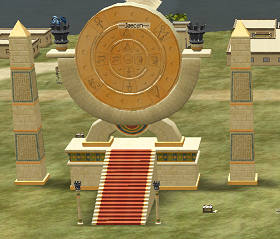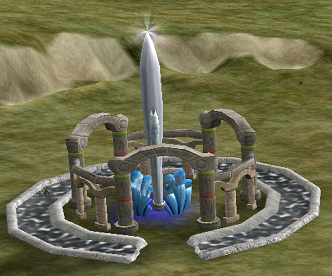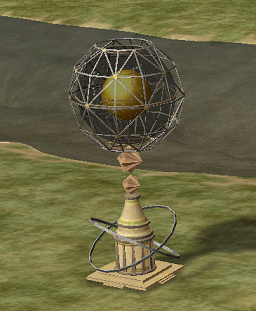The Wiki for Tale 7 is in read-only mode and is available for archival and reference purposes only. Please visit the current Tale 11 Wiki in the meantime.
If you have any issues with this Wiki, please post in #wiki-editing on Discord or contact Brad in-game.
Difference between revisions of "Ancient Monuments"
m |
|||
| Line 9: | Line 9: | ||
A great discovery from Tyana! A series of ancient tablets, inspired by Thoth himself, have been unearthed. If deciphered, these tablets could reveal the secrets of the philosopher's stone and life itself. Unfortunately the text is so cryptic, that even the hieroglyphs themselves were not written down, but are obscured by an empty grid and numeric code. Mastering this code is the first step to discovering the secrets that Thoth graced our ancestors with. An Alchemist's Rune (more commonly known as a nonogram) is a 10x10 square filled in. Individual numbers indicate how many of those cells need to be adjacent to each other, while a comma indicates that there is a gap of one or more cells. The rune designer is given a 10x10 grid to work on, and can choose between one and three colors. Clicking within a cell fills it in, clicking again cycles to the next color or blank. After creating their desired rune, the processor generates the clues along the borders and the puzzle can be opened to the public. Note, it is entirely possible that any particular rune might have multiple valid solutions! Hence being able to finish and judge a puzzle should rely on filling in the grid in such a fashion that it meets the requirements, even if that does not match the designer's initial layout. | A great discovery from Tyana! A series of ancient tablets, inspired by Thoth himself, have been unearthed. If deciphered, these tablets could reveal the secrets of the philosopher's stone and life itself. Unfortunately the text is so cryptic, that even the hieroglyphs themselves were not written down, but are obscured by an empty grid and numeric code. Mastering this code is the first step to discovering the secrets that Thoth graced our ancestors with. An Alchemist's Rune (more commonly known as a nonogram) is a 10x10 square filled in. Individual numbers indicate how many of those cells need to be adjacent to each other, while a comma indicates that there is a gap of one or more cells. The rune designer is given a 10x10 grid to work on, and can choose between one and three colors. Clicking within a cell fills it in, clicking again cycles to the next color or blank. After creating their desired rune, the processor generates the clues along the borders and the puzzle can be opened to the public. Note, it is entirely possible that any particular rune might have multiple valid solutions! Hence being able to finish and judge a puzzle should rely on filling in the grid in such a fashion that it meets the requirements, even if that does not match the designer's initial layout. | ||
| − | ==Ancient | + | ==Ancient Monuments of Worship== |
{{Template:BuildingInfo|image=AMWorship.png|size=N/A|where=Midland Valley 1027,5402|description=Ancient Monument}} | {{Template:BuildingInfo|image=AMWorship.png|size=N/A|where=Midland Valley 1027,5402|description=Ancient Monument}} | ||
''Children of Egypt, the gods look upon you from the firmament and weep bitter tears. Where are their Temples, their devoted followers? Where are their priests? They ask for your dedication in body and spirit and devotions in actions, words and deed. They demand that you humble yourselves before them, that those of you deemed worthy may receive their blessings. The gods have thrown down the challenge and present you with the Test of the Humble Priests. You must humble yourself before your gods, 5 will chose you and test your devotion. Gather together with other priests chosen by your gods and travel to their Temples to dedicate yourselves to them by performing various small sacrifes, rituals, actions, tasks and prayers. Racing against time to appease those gods and fulfil their particular demands, if successful you will gain status in their eyes and be rewarded with their blessing.'' | ''Children of Egypt, the gods look upon you from the firmament and weep bitter tears. Where are their Temples, their devoted followers? Where are their priests? They ask for your dedication in body and spirit and devotions in actions, words and deed. They demand that you humble yourselves before them, that those of you deemed worthy may receive their blessings. The gods have thrown down the challenge and present you with the Test of the Humble Priests. You must humble yourself before your gods, 5 will chose you and test your devotion. Gather together with other priests chosen by your gods and travel to their Temples to dedicate yourselves to them by performing various small sacrifes, rituals, actions, tasks and prayers. Racing against time to appease those gods and fulfil their particular demands, if successful you will gain status in their eyes and be rewarded with their blessing.'' | ||
| + | |||
| + | {{Template:BuildingInfo|image=AMWorship1.png|size=N/A|where=Midland Valley 1027,5402|description=Ancient Monument}} | ||
| + | |||
| + | ''The test consists in getting a cadaver from the university of worship, and giving it a proper burial. The test is intended for a group of 4 players, each receiving part of the instruction and requiring them to get together and figure out the proper treatment and ritual. The cadaver requires specific treatments of salt, perfume and embalming fluid (similar to ambrosia, but would require 3 ingredients). Then the body needs to be wrapped into bandages (made out of linen in a loom). Each cadaver lasts 24 hours before it is no longer suitable to be mummified. once the cadaver is mummified, it requires a burial ceremony. The ceremony should take place at an altar location selected by the University of Worship from which the body was obtained. To begin the ceremony, the mummy needs to be presented to the university for examination. After being deemed worthy, the ceremony could commence, consisting of burning spirits in a brazier, burning incense, reciting a prayer, and an action and offering for the afterlife. The test may require a couple of new items: Bandage; Made from 10-20 linen in a loom, Embalming fluid; Similar to ambrosia, needs to be a mixture of 3 ingredients as requested by the test. Wine would be the base and 2 other random items. The Ritual Item Construction skill would be required in order to make this item. (Or possibly part of the basic chemicals made in either a toxin kitchen or normal kitchen.) Detailed Ritual: Passing the test requires that the ritual would need to be performed 7 times. A group of 4 players are required. One player can start the group, and 3 others must ask to join. The order in which a player joins corresponds to the player's priest number. Priest 1 must ask for the cadaver from the University of Worship. Once the cadaver is acquired, the members of the group will each receive instructions on their portion of the ritual. Each player will have one action to perform, as described below. The ritual must be completed within 24 hours or the body will begin to degrade. If the ritual is not completed, all members must wait an additional 24 hours before beginning the ritual again. Ritual Mummification: Priest 1: Rub the body with salt (approx 50-100 db of salt) Priest 2: Threat the body with embalming fluid (requirements listed above) Priest 3: Apply perfume to the body (random citrus) Priest 4: Wrap the body in bandages (10-20 bandages) Priest 1: Return to the University of Worship from which the cadaver was obtained and get the mortician approval. Burial Ceremony: Once the group have made the mummy correctly, the University will provide the group with information about the deceased from the family, as well as their wish for the burial, including the altar location they wish the ceremony to be performed. Each priest will receive part of the ritual and they will need to figure out the proper sequence. Each priest must; light a brazier with the proper spirit, light incense, recite the proper ritual chant (below) and place the offering to the altar (random fancy item similar on messenger). After all four priests have completed the ritual in the proper sequence, all priests must meditate. Once the ritual is successful, the mummy must be brought to a passed Ka Tomb and lay it to rest there. | ||
Revision as of 13:32, 23 December 2015
Ancient Monument of Art and Music
In Egypt, water is life, and what is life without Art? Artists, you will turn the life-giving water of Egypt into a thing of beauty. Build and arrange decorative basins, and in each of them construct a fountain. Fill the structure with water and watch it take on a life of its own as the water sprays from the fountains and pours from the basins, one into another. In search of serene beauty, amusing interactions, or thunderous amazement, the citizens of Egypt will visit and judge your work, and the most highly regarded creations will advance.
Ancient Monument of Thought
A great discovery from Tyana! A series of ancient tablets, inspired by Thoth himself, have been unearthed. If deciphered, these tablets could reveal the secrets of the philosopher's stone and life itself. Unfortunately the text is so cryptic, that even the hieroglyphs themselves were not written down, but are obscured by an empty grid and numeric code. Mastering this code is the first step to discovering the secrets that Thoth graced our ancestors with. An Alchemist's Rune (more commonly known as a nonogram) is a 10x10 square filled in. Individual numbers indicate how many of those cells need to be adjacent to each other, while a comma indicates that there is a gap of one or more cells. The rune designer is given a 10x10 grid to work on, and can choose between one and three colors. Clicking within a cell fills it in, clicking again cycles to the next color or blank. After creating their desired rune, the processor generates the clues along the borders and the puzzle can be opened to the public. Note, it is entirely possible that any particular rune might have multiple valid solutions! Hence being able to finish and judge a puzzle should rely on filling in the grid in such a fashion that it meets the requirements, even if that does not match the designer's initial layout.
Ancient Monuments of Worship
Children of Egypt, the gods look upon you from the firmament and weep bitter tears. Where are their Temples, their devoted followers? Where are their priests? They ask for your dedication in body and spirit and devotions in actions, words and deed. They demand that you humble yourselves before them, that those of you deemed worthy may receive their blessings. The gods have thrown down the challenge and present you with the Test of the Humble Priests. You must humble yourself before your gods, 5 will chose you and test your devotion. Gather together with other priests chosen by your gods and travel to their Temples to dedicate yourselves to them by performing various small sacrifes, rituals, actions, tasks and prayers. Racing against time to appease those gods and fulfil their particular demands, if successful you will gain status in their eyes and be rewarded with their blessing.
The test consists in getting a cadaver from the university of worship, and giving it a proper burial. The test is intended for a group of 4 players, each receiving part of the instruction and requiring them to get together and figure out the proper treatment and ritual. The cadaver requires specific treatments of salt, perfume and embalming fluid (similar to ambrosia, but would require 3 ingredients). Then the body needs to be wrapped into bandages (made out of linen in a loom). Each cadaver lasts 24 hours before it is no longer suitable to be mummified. once the cadaver is mummified, it requires a burial ceremony. The ceremony should take place at an altar location selected by the University of Worship from which the body was obtained. To begin the ceremony, the mummy needs to be presented to the university for examination. After being deemed worthy, the ceremony could commence, consisting of burning spirits in a brazier, burning incense, reciting a prayer, and an action and offering for the afterlife. The test may require a couple of new items: Bandage; Made from 10-20 linen in a loom, Embalming fluid; Similar to ambrosia, needs to be a mixture of 3 ingredients as requested by the test. Wine would be the base and 2 other random items. The Ritual Item Construction skill would be required in order to make this item. (Or possibly part of the basic chemicals made in either a toxin kitchen or normal kitchen.) Detailed Ritual: Passing the test requires that the ritual would need to be performed 7 times. A group of 4 players are required. One player can start the group, and 3 others must ask to join. The order in which a player joins corresponds to the player's priest number. Priest 1 must ask for the cadaver from the University of Worship. Once the cadaver is acquired, the members of the group will each receive instructions on their portion of the ritual. Each player will have one action to perform, as described below. The ritual must be completed within 24 hours or the body will begin to degrade. If the ritual is not completed, all members must wait an additional 24 hours before beginning the ritual again. Ritual Mummification: Priest 1: Rub the body with salt (approx 50-100 db of salt) Priest 2: Threat the body with embalming fluid (requirements listed above) Priest 3: Apply perfume to the body (random citrus) Priest 4: Wrap the body in bandages (10-20 bandages) Priest 1: Return to the University of Worship from which the cadaver was obtained and get the mortician approval. Burial Ceremony: Once the group have made the mummy correctly, the University will provide the group with information about the deceased from the family, as well as their wish for the burial, including the altar location they wish the ceremony to be performed. Each priest will receive part of the ritual and they will need to figure out the proper sequence. Each priest must; light a brazier with the proper spirit, light incense, recite the proper ritual chant (below) and place the offering to the altar (random fancy item similar on messenger). After all four priests have completed the ritual in the proper sequence, all priests must meditate. Once the ritual is successful, the mummy must be brought to a passed Ka Tomb and lay it to rest there.



